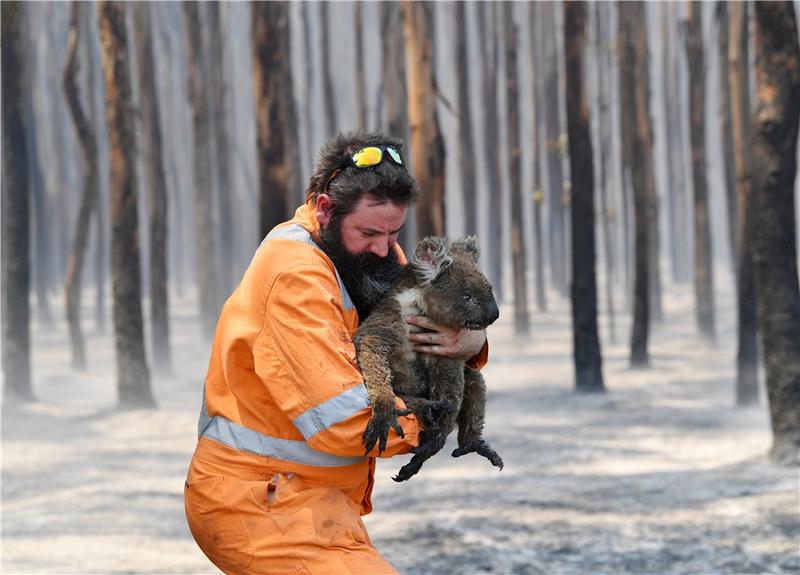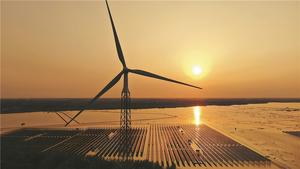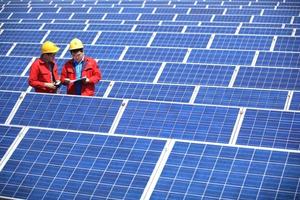This year is set to be the most critical 12 months to tackle global warming since the signing of the Paris Agreement, Angus McNeice reports in London.
 A koala is rescued from bushfires near Cape Borda on Kangaroo Island, southwest of Adelaide, Australia, in January, 2020. (PHOTO / AGENCIES)
A koala is rescued from bushfires near Cape Borda on Kangaroo Island, southwest of Adelaide, Australia, in January, 2020. (PHOTO / AGENCIES)
The year 2019 closed out a decade of abnormal global heating, with the last 10-year period almost certain to be the hottest on record, according to the World Meteorological Organization.
Climate scientists believe this warming is related to increased levels of carbon dioxide, or CO2, in the atmosphere which, at 415 parts per million, are at their highest since the Pliocene Epoch. That's around 3 million years ago, well before the evolution of modern human beings.
Most will be aware of the extreme events linked to the so-called climate crisis, and some are playing out as we speak. Following its hottest and driest year on record, Australia is currently battling a swarm of destructive and fatal wildfires.
For climate change, 2020 is a crucial year. And of course, China’s 14th Five-Year Plan is a big part of the story
Nicholas Stern, British economist
This backdrop has set the stage for what is arguably the most critical year for climate policy since 2016, when 195 nations-including China-signed the Paris Agreement and pledged to prevent global temperatures from rising 2 degrees Celsius above pre-industrial levels.
Several key events in 2020 will influence our collective chances of meeting that goal. Multiple studies indicate that, as things stand, the 2-degree threshold will be breached, so signatories of the Paris Agreement will be challenged to adjust emissions targets at a climate conference in November. That same month, the United States-one of the world's biggest emitters both in absolute terms and per capita-is set to officially withdraw from the Paris Agreement.
And in October, the Communist Party of China is expected to convene for a plenary session to review proposals and offer recommendations for the 14th Five-Year Plan (2021-25) before it is delivered in early 2021.
"For climate change, 2020 is a crucial year," said British economist Nicholas Stern, who is chair of the Grantham Research Institute on Climate Change and the Environment at the London School of Economics. "And of course, China's 14th Five-Year Plan is a big part of the story."
 China has identified wind and solar energy as key areas for growth in the nation's energy mix. (XU CONGJUN / FOR CHINA DAILY)
China has identified wind and solar energy as key areas for growth in the nation's energy mix. (XU CONGJUN / FOR CHINA DAILY)
China's Five-Year Plans are a set of social and economic initiatives that act as a blueprint for national development strategies over a five-year period. And when it comes to climate change, the Five-Year Plan is arguably one of the most important documents on the planet.
Around the turn of the century, Chinese investment in renewable power accounted for less than 6 percent of the global total. But transformative measures in the 11th, 12th and 13th Five-Year Plans-including setting binding indicators for energy consumption and emissions-ushered in an unprecedented period of green development.
According to the UN Environment Program, China invested US$758 billion in renewable energy capacity between 2010 and mid-2019, more than any country or region and representing 29 percent of the global total of US$2.6 trillion. China's contribution alone during that period was just shy of the worldwide total for the previous decade.
This investment created economies of scale and spurred advancements in technology, which in turn drove down the cost of several forms of renewable energy generation, making them competitive with fossil fuels for the first time.
In recent years, Chinese CO2 levels have flattened for sustained periods, creating what Stern calls a "bumpy plateau" for carbon emissions.
Hu Angang, director of the Center for China Study, or CCS, which is a think tank connected with Tsinghua University and the Chinese Academy of Sciences, says that China laid much of the groundwork for this plateau in the drafting of the 13th Five-Year Plan (2016-20).
"We project that the total volume of carbon emissions shall decrease during the period of the 14th Five-Year Plan, which should also greatly affect global emissions," Hu told China Daily.
Hu expects that this next Five-Year Plan will once again have a strong commitment to emissions reduction and clean energy, a prediction supported by the nation's leadership. A report delivered by President Xi Jinping during the 19th National Congress of the CPC in 2017 mentioned "climate change" three times, "low-carbon" four times, "green" 27 times, and "environment" 43 times.
 Technicians check solar panels at a textile company in Jimo, Shandong province. (PHOTO PROVIDED TO CHINA DAILY)
Technicians check solar panels at a textile company in Jimo, Shandong province. (PHOTO PROVIDED TO CHINA DAILY)
Precisely how China will go about controlling emissions over the next five years will only be revealed when the 14th Five-Year Plan is published, and divergent strategies are currently being analyzed.
In the lead up to the Paris Agreement, Premier Li Keqiang said China was committed to peaking its CO2 emissions by 2030. A 2019 study published in Nature, led by researchers from Nanjing University and Harvard University, found that China may be on course to meet that target by as early as 2025.
But a report released by Chinese think tank the National Center for Climate Change Strategy and International Cooperation, or NCSC, warned that on its current trajectory, China could risk missing its emissions target, with CO2 emissions potentially rising from 11 gigatons this year to 14.3 gigatons in 2030. The NCSC also said that, under current policies, China could narrowly miss its commitment to produce 20 percent of its energy through nonfossil fuels by 2030.
The NCSC said the government should consider committing to a cap on CO2 emissions in the 14th Five-Year Plan, limiting CO2 emissions to 10.6 gigatons by 2025. The 13th Five-Year Plan set targets for total energy consumption, though these limits do not take into account the carbonintensity of sources of energy, so an emissions cap would be a noteworthy development.
The CCS proposes writing a unified national carbon tax into the plan, and it too recommends exploring limits on carbon volume.
"As a university think tank, we have been intensively involved in the first steps of providing background research and decision-making consultation for the designation of Five-Year Plans," Hu said. "In terms of the 14th Five-Year Plan, one of the major challenges faced in China is climate change, because China itself is a big victim of frequent natural disasters and abnormal conditions induced by climate change.
"Our suggestion," Hu added, "is that, apart from the obligatory reduction both in total volume and intensity of energy consumption-which was proposed in the 13th Five-Year Plan-the 14th Five-Year Plan should propose the same for carbon emissions, reduction in both volume and intensity."
Looking beyond China's borders, Stern said he hopes for measures which encourage green development in countries within the Belt and Road Initiative, which is a China-proposed economic and infrastructure development plan. Stern said that if the multitude of developing nations along the BRI continue with coal-driven industrial development, it would make the 2-degree target an impossibility.
"The countries in the Belt and Road are independent countries who will make up their own minds about development, but increasingly they are recognizing both the dangers of high carbon development and the opportunities in doing things differently," Stern said.
 An aerial view shows solar panels in the shape of a panda, built by Panda Green Energy Group, in Shanxi province. (ZHAN YAN / XINHUA)
An aerial view shows solar panels in the shape of a panda, built by Panda Green Energy Group, in Shanxi province. (ZHAN YAN / XINHUA)
Last year saw the launch of the Belt and Road Initiative International Green Development Coalition, which is a voluntary UN-backed international network which aims to ensure that the Belt and Road brings long-term green and sustainable development to member countries.
Many of the BRI countries will already be making plans to adjust emissions targets ahead of the 2020 UN Climate Change Conference, which is a meeting of Paris Agreement signatories scheduled to take place in Glasgow, Scotland, this November.
As well as agreeing to the 2-degree target in 2016, signatories also submitted climate action plans, known as nationally determined contributions, or NDCs.
These NDCs are reviewed and adjusted in five-year stock-taking sessions, the first of which will occur in Glasgow. Nations will be expected to come up with more ambitious measures to reduce emissions, as the 2-degree threshold will almost certainly be passed as things stand.
By then, China and the European Union will likely represent the two largest economies coordinating on international climate change policy, as the US is scheduled to exit the Paris Agreement on Nov 4, exactly one year after Washington announced plans to withdraw.
Former UK environment minister Tim Yeo said this will call for close cooperation between China and the EU going forward. He suggests that China and Europe agree to a common set of standards on energy measures, which would in turn encourage the rest of the world to follow suit.
"China holds the key here," said Yeo, who is chairman of UK energy company Waste2Tricity. "I think it's up to China and the EU to get together and solve this problem, as the US administration has opted out. China can be a leader, and I think the EU could partner. And I say that because the EU has been very forward thinking in its approach to climate change. I think the new European Commission President Ursula von der Leyen is clearly very committed on the climate change agenda and I strongly welcome that."
Late last year, Von der Leyen announced the so-called European Green Deal, which details the first EU-wide law on climate change. Von der Leyen describes the deal as "Europe's man on the moon moment" and said she will bring forward proposals in her first 100 days in office, which commenced on Dec 1.
ALSO READ: Crucial role on climate change
With a view to make Europe the world's first "carbon neutral" continent, Von der Leyen wants the EU to cut carbon emissions by 50 to 55 percent from 1990 levels by 2030, a significant improvement on the current target of 40 percent.
In December, 27 of the EU's 28 member states committed to the goal of carbon neutrality by 2050. Two nations-the Czech Republic and Hungary-agreed to the target on the provision that there would be an increased role for nuclear power, while Poland-which relies heavily on coal-abstained.
One of the proposals in the deal is to establish a carbon border tax on imports from countries that fail to act on emissions. The European Green Deal has sparked criticism on both sides of the debate-some critics argue its measures are too drastic and industry will suffer, while environmental groups say the emissions target is too low.
"Ursula von der Leyen is promising the European Green Deal will tackle the runaway climate crisis and the massive destruction of nature. But the climate targets she's proposing would be too little too late," Greenpeace EU spokeswoman Franziska Achterberg said in a statement.
Greenpeace called on Von der Leyen to up the emissions reduction target to 65 percent.
"The climate, ecological and inequality crises require a fundamental rethink of the economic system that for decades has rewarded pollution, environmental destruction and human exploitation," Achterberg said.
READ MORE: UNEP chief lauds China's global leadership on climate action
Yeo says that he believes there is room for integration and alignment between China and the EU on climate-related policies. He says that if both regions agreed on common standards in areas such as vehicle emissions and energy efficiency in the building sector, it would encourage global markets to go the same way.
"There is the opportunity for the EU to become the global partner of China, for mutual benefit and the world's benefit," Yeo said.


